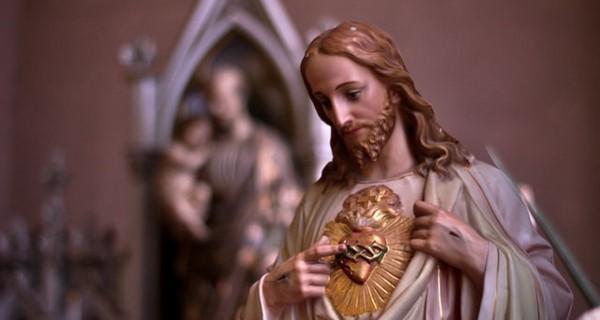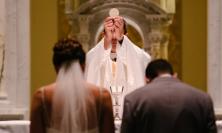On the feast of the Sacred Heart, we hear St Paul’s words to the Ephesians in which he prays that they, ‘rooted and grounded in love’, will know Christ dwelling in their hearts. The feast of and devotion to the Sacred Heart of Jesus invite us to be strengthened by the love of God that dwells in the whole of creation, and to recognise and imitate it in our lives, says Teresa White FCJ.
The imagery associated with the Most Sacred Heart of Jesus, with Jesus pointing to his exposed human heart, which is topped with a crucifix and surrounded by flames and thorns, does not appeal to everyone. Nevertheless, regardless of the aesthetic merits of such statues and pictures, this devotion springs from the most important religious truth of all: love is the essence of who God is. John says this clearly and simply in his first letter: ‘God is love, and those who abide in love abide in God, and God abides in them’ (1 John 4:16). Popular jargon waxes poetic when it speaks of love: love is ‘a red, red rose’, ‘an endless, aching need’; and the heart is its symbol. Recognising God’s loving presence in our history, the Church uses this human symbol of love to represent God’s love, ‘which was revealed among us in this way: God sent his only son into the world’(1 John 4:9). And so, on the feast of the Sacred Heart, we are reminded that God is love, and that love, only love, inspired all that God’s Son, Jesus the Christ, did and said and suffered during his life on earth.
Pierre Teilhard de Chardin, the Jesuit priest, mystic, theologian and scientist, kept a picture of the Sacred Heart of Jesus on his desk. Believing that God dwells at the heart of existence, Teilhard sees Jesus, God in human form, as God’s love made manifest. He believed that God’s intimate presence, love, burning in ‘the heart of God’, embraces the whole of creation, and this means that all of matter and all of life is touched by the divine. ‘Love alone,’ he wrote, ‘is capable of uniting living beings in such a way as to complete and fulfil them, for it alone takes them and joins them by what is deepest in themselves.’[1] His point is that all the sentient creatures of the earth instinctively seek unity, and it is the energy of love that propels them towards it. Teilhard is highlighting here the relational character of all reality, and hence the key importance of love in the life of the cosmos and in our own lives. Each act of love, he held, no matter how small or hidden, moves all of reality closer to full union. His deepest desire was that we humans, by the way we live, should ‘harness for God the energies of love’ and in doing so, discover healing and wholeness. For Teilhard, love is quite literally what makes the world go round, and a universal love is not only humanly possible, but is the only true expression of love.[2] Through love, the world must be transformed, and that is what Jesus came to do. Interestingly, in 1881, the year of Teilhard’s birth, Gerard Manley Hopkins said something very similar in a letter to his friend Robert Bridges: ‘All things therefore are charged with love, are charged with God and, if we know how to touch them, give off sparks and take fire, yield drops and flow, ring and tell of him’. These words of the poet find an echo in The Phenomenon of Man, where Teilhard writes: ‘Driven by the forces of love, the fragments of the world seek each other so that the world may come into being’.[3]
The Judaeo-Christian tradition sees the whole of creation as God’s beloved handiwork, so it is not surprising to find that love has a central place in all four gospels. In the synoptics, Jesus incarnates God’s love by reaching out to the poor and despised members of the society of his time, and by performing miracles of healing and compassion. Through parable, word and action, he teaches that love of God is inseparable from love of neighbour, emphasises the importance of generosity to those in need, and says that his followers must love not only friends and family, but enemies too. In Matthew’s version of the Beatitudes, in eight brushstrokes, an amazingly vibrant portrait of Jesus is drawn, giving clarity and definition to the features of the person whom Paul calls ‘the image of the invisible God’ (Colossians 1:15). And that unseen God is a God of love: Jesus’s contemporaries saw how he took the side of the excluded, the disreputable, the unimportant; how he comforted the sorrowful and healed the sick; how he stood up for what is right and just; how gentle and kind he was, how open and honest; how compassionate he was to those in any kind of need or distress, bringing peace to troubled hearts; how he forgave even those who hated him and wanted to kill him. Gradually, Jesus’s close followers came to realise that this is what God is like: ‘No one has ever seen God. It is God the only Son, who is close to the Father’s heart, who has made him known’ (John 1:18).
In the fourth gospel, the theme of love pervades every aspect of the life of Jesus and is at the heart of his teaching, for John sees the revelation of God’s love as fundamental to the saving mission of Jesus: ‘For God so loved the world that he gave his only Son, so that everyone who believes in him may not perish but may have eternal life’ (John 3:16). The good news is that God loves us and the whole of creation, and God reveals this love through the life of Jesus. At the Last Supper, Jesus shows his love by washing the feet of his disciples, even the feet of Judas, who will go on to betray him (13:26). This is the pattern of love that Jesus expects from all his followers: they are to love not only those who love them, but also those who hate them (15:18). After the meal, in the farewell discourse, Jesus discusses love with them, and ends by praying that they may be filled with the same love with which God loves him (17:26). It is a chain of love that he describes: the Father loves Jesus, Jesus loves the disciples, and they in their turn must love one another (15:12-17). One can imagine the disciples asking Jesus what all this talk about love means – so he instructs them, patiently repeating that love is the heart of his message, telling them that they are his friends, not servants, and that he will always love them.
Historically, there is evidence of private devotion to the Sacred Heart of Jesus in Europe as early as the 11th and 12th centuries, and Julian of Norwich in the 14th may well have been familiar with it. Anyone reading her book, Showing of Love, could not fail to be touched by her utter conviction that God ‘takes pleasure in his people’ (Psalm 149:4), and few have expressed this delight in God’s love as ardently as she did. Indeed, Julian’s whole theology could be summed up in one line: ‘Love is God’s meaning’.[4] In the 1600s, St Jean Eudes honoured the Sacred Heart of Jesus with an Office and established a feast for it, but it was through the visions of St Margaret Mary Alacoque, a few decades later, that the Sacred Heart became a focus of prayer and celebration throughout the Catholic world. Would a renewal of this devotion in the Church of today remind us that at the beating heart of the evolving universe, God’s loving presence guides everything that exists? Would it encourage us to deepen our relationships with one another since, as Pope Francis says in Evangelii Gaudium, ‘loving others is a spiritual force drawing us to union with God’ (§272)? Would it make us more aware of the radiance of God’s love, shining in our broken world? Would it summon us to make every effort to repair the damage caused to the natural environment by our loveless disregard for the workings of God’s creation?
It is only when we know ourselves loved that we can love in our turn, and our pandemic-ravaged, violent, unjust world has a deep need of the love and kindness of God. In those pictures and statues of the Sacred Heart that we see in so many of our churches, Jesus is telling us that God has a warm, tender and loving concern for humanity and for all of creation. Julian of Norwich would have agreed wholeheartedly: ‘Our Lord gave me spiritual insight into the unpretentious manner of his loving. I saw that for us he is everything that is good, comforting and helpful; he is our clothing, who, for love, wraps us up, holds us close; he entirely encloses us for tender love, so that he may never leave us, since he is the source of all good things for us, as I understand it’.[5] The heart of Jesus, she seems to be telling us, is God’s heart in the world, and ‘the heart of the eternal is most wonderfully kind’.[6]
Sister Teresa White belongs to the Faithful Companions of Jesus. A former teacher, she spent many years in the ministry of spirituality at Katherine House, a retreat and conference centre run by her congregation in Salford.
[1] Pierre Teilhard de Chardin SJ, The Phenomenon of Man (Collins, 1959), p.265.
[2] Ibid., p.266.
[3] Ibid., p.265.
[4] Julian of Norwich, Showing of Love, chapter 86.
[5] Ibid., chapter 5.
[6] From the hymn ‘There’s a Wideness in God’s Mercy’ by Frederick W. Faber.






